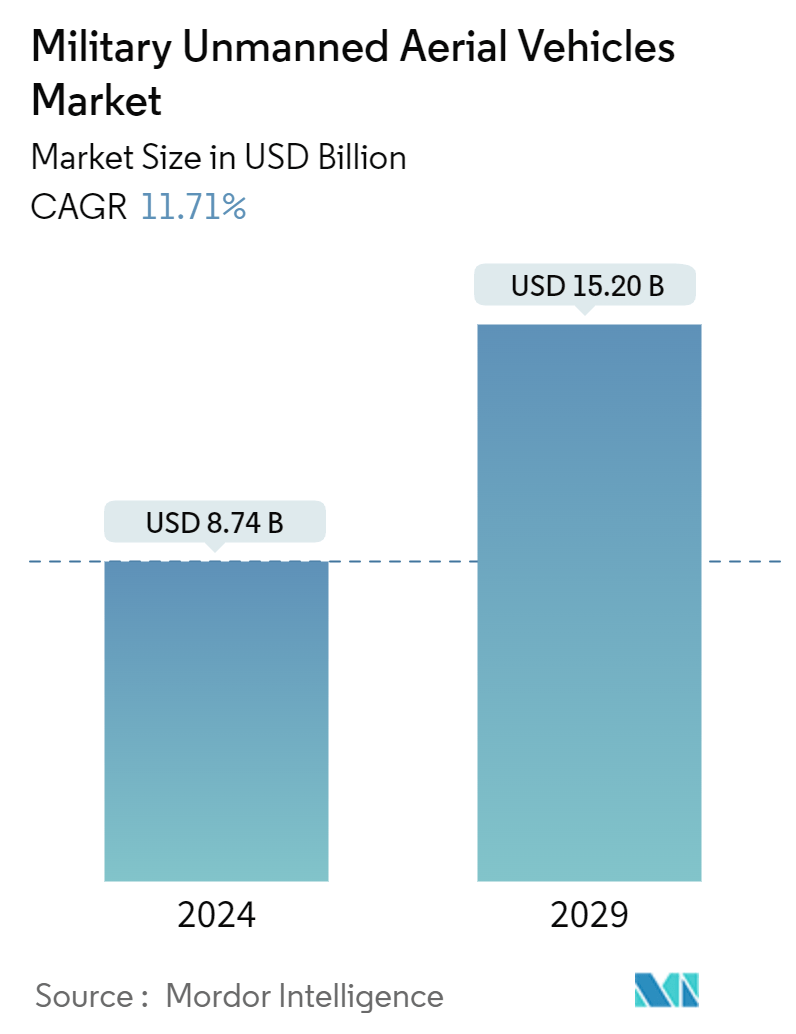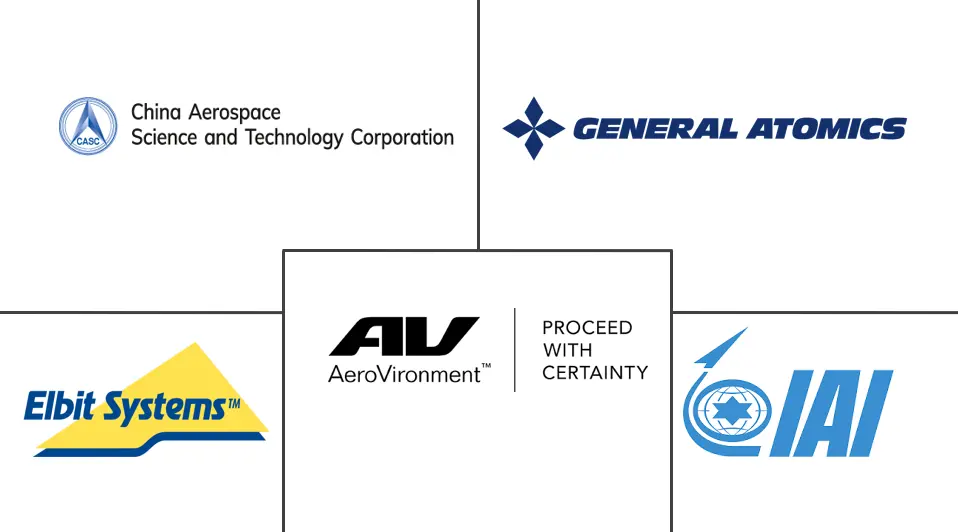Market Size of Military Unmanned Aerial Vehicles Industry

| Study Period | 2019 - 2029 |
| Market Size (2024) | USD 8.74 Billion |
| Market Size (2029) | USD 15.20 Billion |
| CAGR (2024 - 2029) | 11.71 % |
| Fastest Growing Market | Asia-Pacific |
| Largest Market | North America |
| Market Concentration | Medium |
Major Players
*Disclaimer: Major Players sorted in no particular order |
Military Unmanned Aerial Vehicles Market Analysis
The Military Unmanned Aerial Vehicles Market size is estimated at USD 8.74 billion in 2024, and is expected to reach USD 15.20 billion by 2029, growing at a CAGR of 11.71% during the forecast period (2024-2029).
The past decade has seen a significant surge in the adoption of military UAVs. End-users now deploy various models for tasks ranging from combat operations to surveillance, border patrolling, and inspections. Notably, advancements in next-gen military UAVs show no signs of slowing down. They are poised for accelerated growth. Real-time information is increasingly becoming the cornerstone of success in critical military missions. It equips warfighters, commanders, and troops with the necessary intelligence to safeguard themselves. As a result, there is a rising emphasis on superior tactical intelligence, surveillance, and reconnaissance, driving global armed forces to ramp up their UAV acquisitions.
While the drone market is growing, it faces significant hurdles. Safety concerns, airspace congestion, and stringent manufacturing standards set by many nations are key challenges. These standards not only impact local operations but also affect the global export of UAVs and their components. Despite these challenges, the drone industry is witnessing consolidation and attracting substantial investments. Industrial conglomerates, IT consultancies, and prominent industrialists are increasingly recognizing the potential of UAVs in defense. These factors and a growing awareness of UAV capabilities are set to propel the market studied during the forecast period.
Military Unmanned Aerial Vehicles Industry Segmentation
An unmanned aerial vehicle (UAV), commonly known as a drone, is a military aircraft that can operate autonomously, remotely, or via a blend of both methods. Outfitted with sensors, target designators, offensive ordnance, and electronic transmitters, these drones are designed primarily for engaging and neutralizing enemy targets.
The military unmanned aerial vehicles market is segmented by type, application, and geography. By type, the market is segmented into fixed-wing and VTOL. By application, the market is classified as combat and non-combat. The report also covers the market sizes and forecasts for the military unmanned aerial vehicles market in major countries across different regions. For each segment, the market size is provided in terms of value (USD).
| By Type | |
| Fixed-wing | |
| VTOL |
| By Application | |
| Combat | |
| Non-combat |
| By Geography | |||||||
| |||||||
| |||||||
| |||||||
| |||||||
|
Military Unmanned Aerial Vehicles Market Size Summary
The military unmanned aerial vehicles (UAV) market is experiencing robust growth, driven by the increasing adoption of these systems for a variety of military applications, including combat operations, surveillance, and reconnaissance. The demand for advanced UAVs is being propelled by the need for real-time intelligence, which is crucial for the success of modern military missions. This has led to a significant emphasis on enhancing tactical intelligence and surveillance capabilities, prompting global armed forces to expand their UAV fleets. Despite challenges such as safety concerns and stringent regulatory standards, the market is witnessing substantial investments and consolidation, with major industrial players recognizing the strategic potential of UAVs in defense operations.
The market is also witnessing a transformative shift with the rise of indigenous unmanned combat aerial vehicle (UCAV) projects and the global influence of Chinese-made armed drones. The strategic advantages offered by UCAVs, such as cost-effectiveness and reduced operational risks, are making them essential assets for armed forces worldwide. Political tensions and the need for enhanced aerial capabilities are further driving the demand for UCAVs. Regions like Asia-Pacific are leading in procurement initiatives, fueled by increased defense spending and geopolitical tensions. Countries such as China, India, South Korea, and Japan are actively investing in UAV development and procurement, anticipating significant market growth. The presence of key players like Israel Aerospace Industries, General Atomics, and Elbit Systems, along with strategic collaborations and technological advancements, is expected to further bolster the market during the forecast period.
Military Unmanned Aerial Vehicles Market Size - Table of Contents
-
1. MARKET DYNAMICS
-
1.1 Market Overview
-
1.2 Market Drivers
-
1.3 Market Restraints
-
1.4 Industry Attractiveness - Porter's Five Forces Analysis
-
1.4.1 Threat of New Entrants
-
1.4.2 Bargaining Power of Buyers/Consumers
-
1.4.3 Bargaining Power of Suppliers
-
1.4.4 Threat of Substitute Products
-
1.4.5 Intensity of Competitive Rivalry
-
-
-
2. MARKET SEGMENTATION
-
2.1 By Type
-
2.1.1 Fixed-wing
-
2.1.2 VTOL
-
-
2.2 By Application
-
2.2.1 Combat
-
2.2.2 Non-combat
-
-
2.3 By Geography
-
2.3.1 North America
-
2.3.1.1 United States
-
2.3.1.2 Canada
-
-
2.3.2 Europe
-
2.3.2.1 United Kingdom
-
2.3.2.2 France
-
2.3.2.3 Germany
-
2.3.2.4 Russia
-
2.3.2.5 Rest of Europe
-
-
2.3.3 Asia-Pacific
-
2.3.3.1 China
-
2.3.3.2 Japan
-
2.3.3.3 India
-
2.3.3.4 South Korea
-
2.3.3.5 Rest of Asia-Pacific
-
-
2.3.4 Latin America
-
2.3.4.1 Brazil
-
2.3.4.2 Rest of Latin America
-
-
2.3.5 Middle East and Africa
-
2.3.5.1 United Arab Emirates
-
2.3.5.2 Saudi Arabia
-
2.3.5.3 Turkey
-
2.3.5.4 Rest of Middle East and Africa
-
-
-
Military Unmanned Aerial Vehicles Market Size FAQs
How big is the Military Unmanned Aerial Vehicles Market?
The Military Unmanned Aerial Vehicles Market size is expected to reach USD 8.74 billion in 2024 and grow at a CAGR of 11.71% to reach USD 15.20 billion by 2029.
What is the current Military Unmanned Aerial Vehicles Market size?
In 2024, the Military Unmanned Aerial Vehicles Market size is expected to reach USD 8.74 billion.

